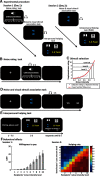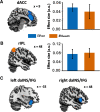Computational and Neurobiological Substrates of Cost-Benefit Integration in Altruistic Helping Decision
- PMID: 33674417
- PMCID: PMC8051690
- DOI: 10.1523/JNEUROSCI.1939-20.2021
Computational and Neurobiological Substrates of Cost-Benefit Integration in Altruistic Helping Decision
Abstract
Although altruistic behaviors, e.g., sacrificing one's own interests to alleviate others' suffering, are widely observed in human society, altruism varies greatly across individuals. Such individual differences in altruistic preference have been hypothesized to arise from both individuals' dispositional empathic concern for others' welfare and context-specific cost-benefit integration processes. However, how cost-benefit integration is implemented in the brain and how it is linked to empathy remain unclear. Here, we combine a novel paradigm with the model-based functional magnetic resonance imaging (fMRI) approach to examine the neurocomputational basis of altruistic behaviors. Thirty-seven adults (16 females) were tested. Modeling analyses suggest that individuals are likely to integrate their own monetary costs with nonlinearly transformed recipients' benefits. Neuroimaging results demonstrate the involvement of an extended common currency system during decision-making by showing that selfish and other-regarding motives were processed in dorsal anterior cingulate cortex (ACC) and right inferior parietal lobe in a domain-general manner. Importantly, a functional dissociation of adjacent but different subregions within anterior insular cortex (aINS) was observed for different subprocesses underlying altruistic behaviors. While dorsal aINS (daINS) and inferior frontal gyrus (IFG) were involved in valuation of benefactors' costs, ventral aINS and middle INS (vaINS/mINS), as empathy-related regions, reflected individual variations in valuating recipients' benefits. Multivariate analyses further suggest that both vaINS/mINS and dorsolateral prefrontal cortex (DLPFC) reflect individual variations in general altruistic preferences which account for both dispositional empathy and context-specific other-regarding tendency. Together, these findings provide valuable insights into our understanding of psychological and neurobiological basis of altruistic behaviors.SIGNIFICANCE STATEMENT Altruistic behaviors play a crucial role in facilitating solidarity and development of human society, but the mechanisms of the cost-benefit integration underlying these behaviors are still unclear. Using model-based neuroimaging approaches, we clarify that people integrate personal costs and non-linearly transformed other's benefits during altruistic decision-making and the implementations of the integration processes are supported by an extended common currency neural network. Importantly, multivariate analyses reveal that both empathy-related and cognitive control-related brain regions are involved in modulating individual variations of altruistic preference, which implicate complex psychological and computational processes. Our results provide a neurocomputational account of how people weigh between different attributes to make altruistic decisions and why altruistic preference varies to a great extent across individuals.
Keywords: altruistic behavior; cost-benefit integration; empathy; model-based fMRI.
Copyright © 2021 the authors.
Figures







Similar articles
-
A neurocomputational account of the link between social perception and social action.Elife. 2025 Apr 16;12:RP92539. doi: 10.7554/eLife.92539. Elife. 2025. PMID: 40237179 Free PMC article.
-
Decoding the Charitable Brain: Empathy, Perspective Taking, and Attention Shifts Differentially Predict Altruistic Giving.J Neurosci. 2016 Apr 27;36(17):4719-32. doi: 10.1523/JNEUROSCI.3392-15.2016. J Neurosci. 2016. PMID: 27122031 Free PMC article.
-
How do self-interest and other-need interact in the brain to determine altruistic behavior?Neuroimage. 2017 Aug 15;157:598-611. doi: 10.1016/j.neuroimage.2017.06.040. Epub 2017 Jun 20. Neuroimage. 2017. PMID: 28645841
-
Neurocomputational models of altruistic decision-making and social motives: Advances, pitfalls, and future directions.Wiley Interdiscip Rev Cogn Sci. 2021 Nov;12(6):e1571. doi: 10.1002/wcs.1571. Epub 2021 Aug 2. Wiley Interdiscip Rev Cogn Sci. 2021. PMID: 34340256 Free PMC article. Review.
-
Neural signatures of prosocial behaviors.Neurosci Biobehav Rev. 2020 Nov;118:186-195. doi: 10.1016/j.neubiorev.2020.07.006. Epub 2020 Jul 21. Neurosci Biobehav Rev. 2020. PMID: 32707344 Free PMC article. Review.
Cited by
-
Divergent Neural Mechanisms of Self-Concerned and Prosocial Decision-Making Under High and Low Cognitive Loads.Hum Brain Mapp. 2025 Aug 1;46(11):e70315. doi: 10.1002/hbm.70315. Hum Brain Mapp. 2025. PMID: 40767468 Free PMC article.
-
Neural basis of prosocial behavior.Trends Neurosci. 2022 Oct;45(10):749-762. doi: 10.1016/j.tins.2022.06.008. Epub 2022 Jul 16. Trends Neurosci. 2022. PMID: 35853793 Free PMC article. Review.
-
Context Modulates Perceived Fairness in Altruistic Punishment: Neural Signatures from ERPs and EEG Oscillations.Brain Topogr. 2024 Sep;37(5):764-782. doi: 10.1007/s10548-024-01039-1. Epub 2024 Mar 6. Brain Topogr. 2024. PMID: 38448713
-
A neurocomputational account of the link between social perception and social action.Elife. 2025 Apr 16;12:RP92539. doi: 10.7554/eLife.92539. Elife. 2025. PMID: 40237179 Free PMC article.
-
Prosocial decision-making under time pressure: Behavioral and neural mechanisms.Hum Brain Mapp. 2023 Dec 1;44(17):6090-6104. doi: 10.1002/hbm.26499. Epub 2023 Sep 29. Hum Brain Mapp. 2023. PMID: 37771259 Free PMC article.
References
-
- Batson CD, Shaw LL (1991) Evidence for altruism: toward a pluralism of prosocial motives. Psychol Inq 2:107–122. 10.1207/s15327965pli0202_1 - DOI
Publication types
MeSH terms
LinkOut - more resources
Full Text Sources
Other Literature Sources
